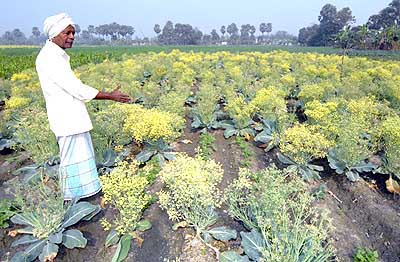This man was once lauded by former chief minister Satyendra Narain Sinha for his "innovative agriculture brain". He was also called annadata at Lalganj where he tilled 14 acre land to grow high-yieldng wheat. But all that was forgotten. But this unsung green revolution man has of late turned to yellow cultivation that makes gold. And do not mistake those "yellow flames" in Hariharpur fields, barely 20 km from Patna, for mustard crops swaying in anticipation of spring.

It is a high-cost local variety of cauliflower seeds, sold across Bihar, Rajasthan, Madhya Pradesh and Maharashtra under exclusive Vaishali brand of " satya beej (true seeds)" or Amrit for its absolute organic preparation.
The cauliflower seeds fields have two other simultaneous crops, potato and maize, sharing the same silty loam soil to ensure optimization. The three crops also contribute to each other's nutrition.
All this and more are happening in backyard of state capital at this non-descript Vaishali village.
The yellow revolution man of Vaishali is Bindeshwar Prasad Singh (67), a farmer owning just 2.5 acre of land but still making gold. No matter he was not chosen for last year's Kisan Samman by Bihar government, the Indian Vegetable Research Institute at Varanasi gave him silver medal for year 2007.
Since 2001, he has been producing 1.5 quintal to 2 quintal cauliflower seeds from his two acre land. Of late, Singh purchased two more acres of land for Rs 10 lakh at his village to grow more crops. One cauliflower harvest at two acre of land costs him about one lakh rupees. But see his yield -- Rs 10-12 lakh for that. If government comes foward to help brand his seeds, it could go up to Rs 15 lakh.
Cauliflower seeds, grown by this farmer, are sold at Rs 7,500-Rs Rs 8,000 per kg as gainst international price of Rs 12,000-Rs 15,000 per kg. Satyabeej producing Early Kuwari cauliflower, is an exclusive Vaishali variety and can well be patented on lines of our Shahi Litchi and Maldah Mango. About 20 farmers of Hariharpur and surrounding villages have been growing cauliflower seeds.Farmers who emulate his multi-crop method would make fast money. His only son Amod, a first class science graduate, did not even think of looking for a job. "I am very happy helping out my father at fields and want to carry on the experiment a bit further to effect the "yellow revolution" in length and breath of Vaisahli, Samastipur and Darbhanga", said Amod adding "My father was a yard master with petty earning of Rs 700 per month. He had to sell most of our paternal land to support a family of seven".But it has been a long journey for this unsung hero of Vaishali since 1965. After passing his matriculation in 1956, he took to cultivation out of choice at his share of 2.5 acre. By 1965, when green revolution swept Punjab, he became aware of high-quality seeds of wheat.
Sonra-64, a wheat variety, gave him yield of 28 quintal per acre and that became the turning point for this agriculture enthusiasm.
During 1966-67, he accepted a challenge from then minister Satyendra Narayan Sinha later Bihar CM to show "his feet at his 14 acre Langanj (Vaishali) plot". He stayed at Lalganj from 1966 to 1973 re-iterating his high-yielding feat. But no government laurel came his way. "I was local annadata (grain-provider) for my peers and fellow farmers for teaching them new cultivation method. But no one came forward to take my experimentation method at state level", he rued.
After Rajendra Agriculture Research Institute was set up at the village in 2007, he was provided with technical know-how".
The institute's programme coordinator Brajesh Shahi lauded "incredible efforts" of Singh. "Bindeshwar's switching over from chemical cultivation to organic method has worked wonders and is highly sustainable.
The institute, he said, taught him laying Pheromone trap, which has female insects' hormone in a cotton wads, to catch pests. Wooden perches are also erected in fields to invite birds to eat insects. Bee-hives are also there to help in cross-pollination of cauliflower seeds. Ginger, neem and chilly solutions are used for pest control.
Shahi said: "If we can provide farmers foundation seed, it will be automatically ratified by other states giving us international price". At present, Vaishali cauliflower seeds are sold at Rs 7,500 per kg as against branded seeds' rates of Rs 13,000 to Rs 15,000 per kg.
Cauliflower seeds are grown between July and mid March, Potato between December and March and Maize between January and May. The field is minus crop only for one and a half month.
Here are the ones who claim to reap rich harvest from cauliflower gold: Alok Chandra Roy, Krishna Chandra Mohan, Rajendra Shah, Mohammed Nayeem and Rajesh Singh. They all salute this green revolution man and wish him fame of Hillman Dasrath Manjhi.
Comments...
Satyavrat Kumar